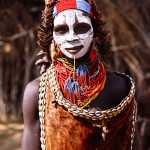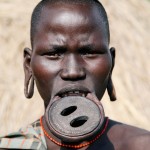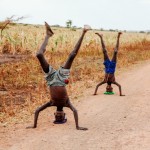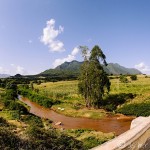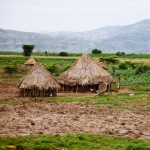Today is our second day in Omo Valley (we spent most of day one just driving to get here) and we’re about to visit our first tribe — a Hamar tribe.
I’m uneasy about what to expect. Last night’s encounter with tribeswomen after our missed bull jump experience wasn’t a positive first impression — I gave them the standard photo tip money and they took it without posing, saying it wasn’t enough. Lesson learned: tip after taking photos. Rookie mistake.
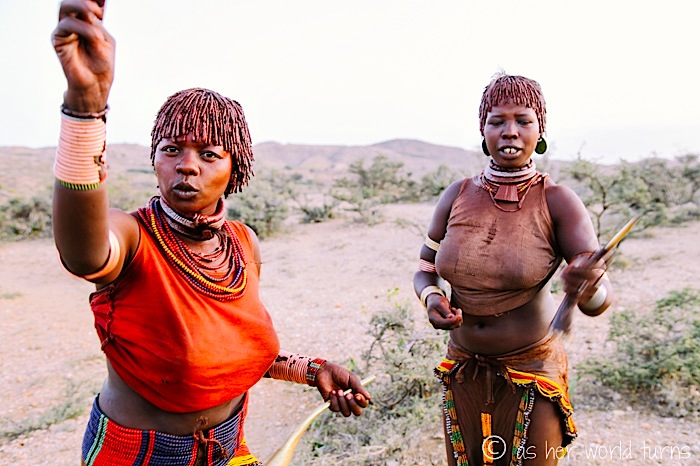
But that exchange (or lack of exchange) brought up questions about tipping at dinner last night with our new Australian friends. With certain tribes, their guide was able to negotiate a flat tipping fee (to be distributed among the tribes) instead of tipping each individual member you take a photo of. This is huge because — as Mike and I are about to experience first-hand today — the process of deciding who to photograph within a tribe is uncomfortable at best.
Let me set the stage: our big fancy car (any working car in these parts is fancy) pulls up to the tribe. Before we open the doors, nearly all of the members have gathered around the vehicle, eager to tug at our sleeves and ask to be photographed, because to be photographed is to be tipped. Then the tourists are in the awkward position of having to decide who to photograph among these 30-something people. Can you imagine? If we pick one little girl or boy over another, it’s like saying that one is better. It creates unnecessary competition and bad feelings. I imagine this is what it’s like to be a casting director or a beauty pageant judge — “umm, okay, I pick you” — and I’m entirely uncomfortable with the set-up. Yesterday at the markets when we first encountered local tribespeople I didn’t take a single photo because it was too awkward, which is a tremendous shame because we came across so many visually striking people. It kills me to pass up photo opportunities but I’m reticent to navigate the process of selecting someone out of the crowd.
Doesn’t it make more sense to pay a flat fee to take photos of everyone? Mike and I ask our driver if he or our local guide can inquire about a similar deal with today’s tribes. Apparently this is unusual — the tribes people fully expect to be paid 5 birr (25 cents) every time someone takes a photo of them, but our local guide offers to ask.
Well, it sort of works! He’s able to strike a deal with the head of one of the village’s families — I pay the equivalent of $5 USD to take unlimited photos of one particular family during our 20-minute visit. The patriarch tells his wives (he has several) and children about the deal and they very kindly pose for us. The only downside is that the other families of this tribe don’t get our business because we’ve arranged a deal with just this particular family.
The head of the family is the man below right. One of his wives works on the thatch roof of the rondavel below left.
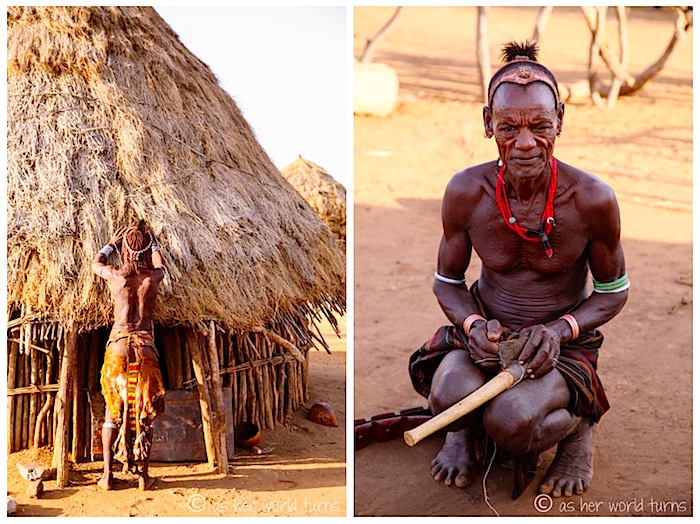
These children us a knife to put a hole in this strip of leather — perhaps to use it as a belt, weapon holder, or necklace of some sort.
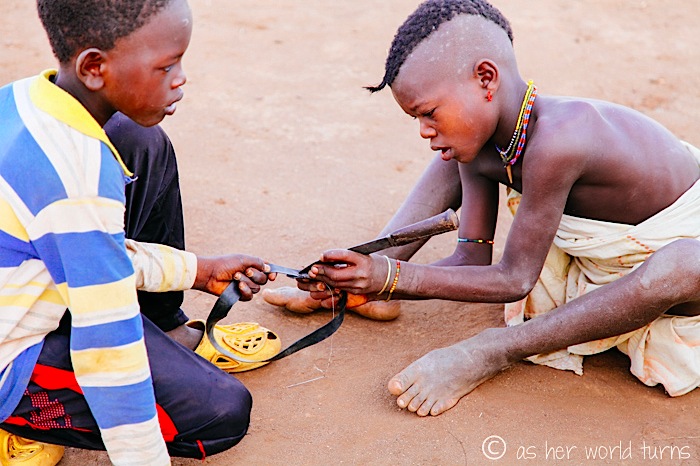
Our local guide motions me to follow him into this rondavel and I audibly gasp as I enter — the light streams through the branches like laser beams, highlighting the dust in mid-air.

One of the other wives has her nose to the grindstone (almost literally) as she prepares grains for food preparation.

A young child peeks into the rondavel as the woman pours out more grains to grind — they turn into a white power, she has a whole pile built up in front of her grindstone.
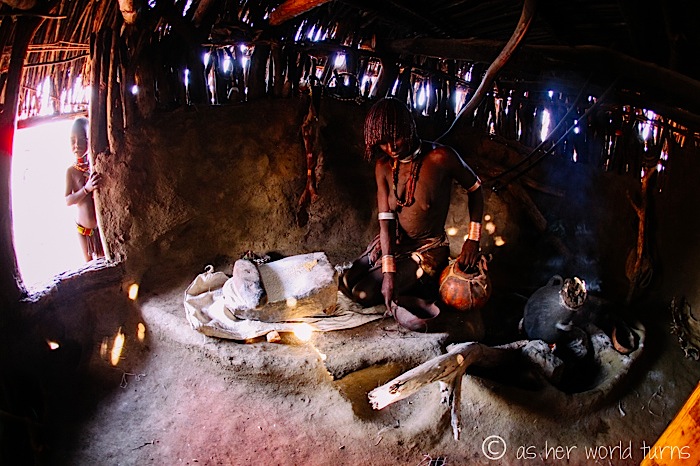

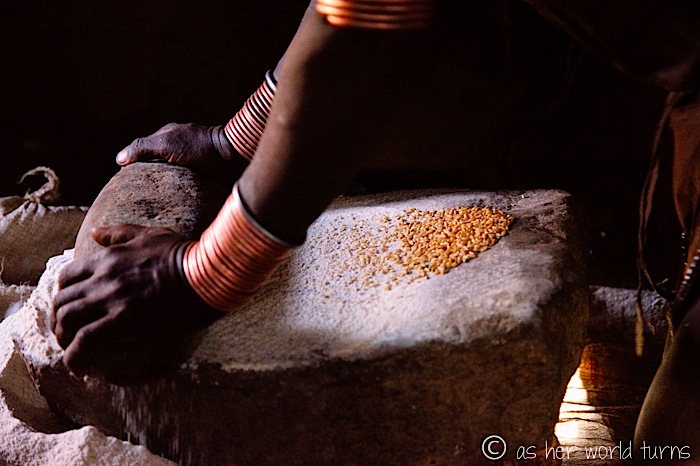
It’s quite dark inside the rondavel so I use a high ISO (up to 6400) and these images turned out a little grainy, but I love them nonetheless. This next one is my favorite as the woman pauses to look outside. She looks lost in thought.

During the few minutes I’m inside the rondavel, the local guide sits next to me providing facts about the daily life of these people, and the woman never once glances my way or otherwise stops her work. I don’t know it at the time because this is our first tribal visit, but it’s near impossible to capture the members just going about their day; often their actions are merely performances to generate tip money from the moment we get out of the car. But perhaps since we’ve arranged this deal with her husband, this woman is content to continue her chore without posing. This turns out to be the only genuine encounter I have in Omo Valley.

You can see the progress she’s made below — that pile of finely powdered grain will then be used for making porridge or a starch that’s similar to mashed potatoes.

This is the local guide showing us around the tribe. He lives in a nearby village (he’s not a member of the tribe).
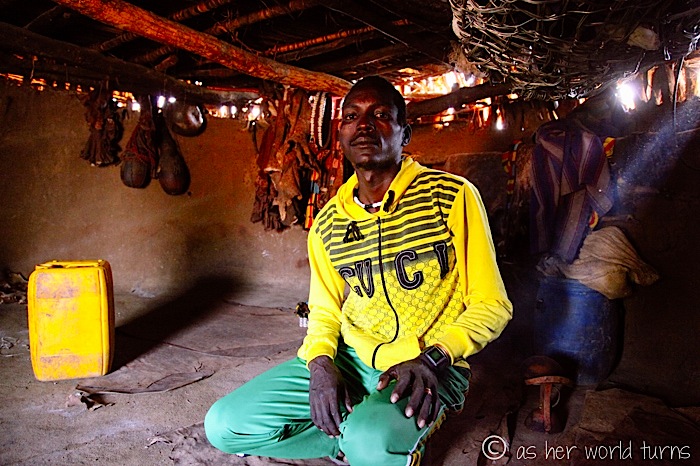
He points to the cow hide hanging inside the rondavel and explains that it was likely worn by a young warrior during his bull jump ceremony.

Back outside, the father poses with his three teenage daughters.
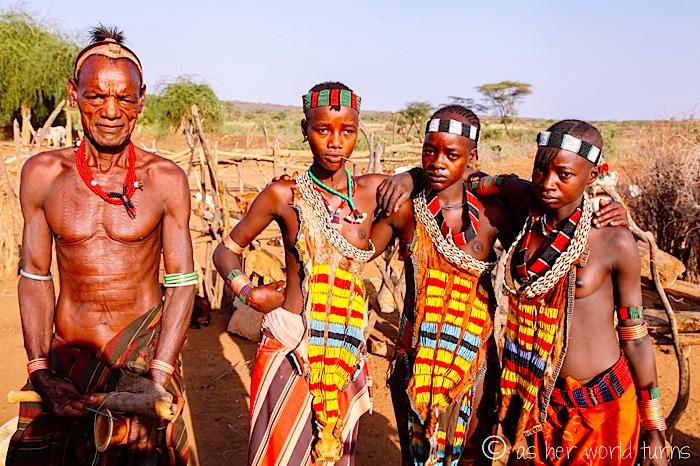
You’ll notice that a pattern has been etched into his skin. This is quite common among all the tribes we visit and it sort of makes me squeamish to think of how they achieved this particular look.
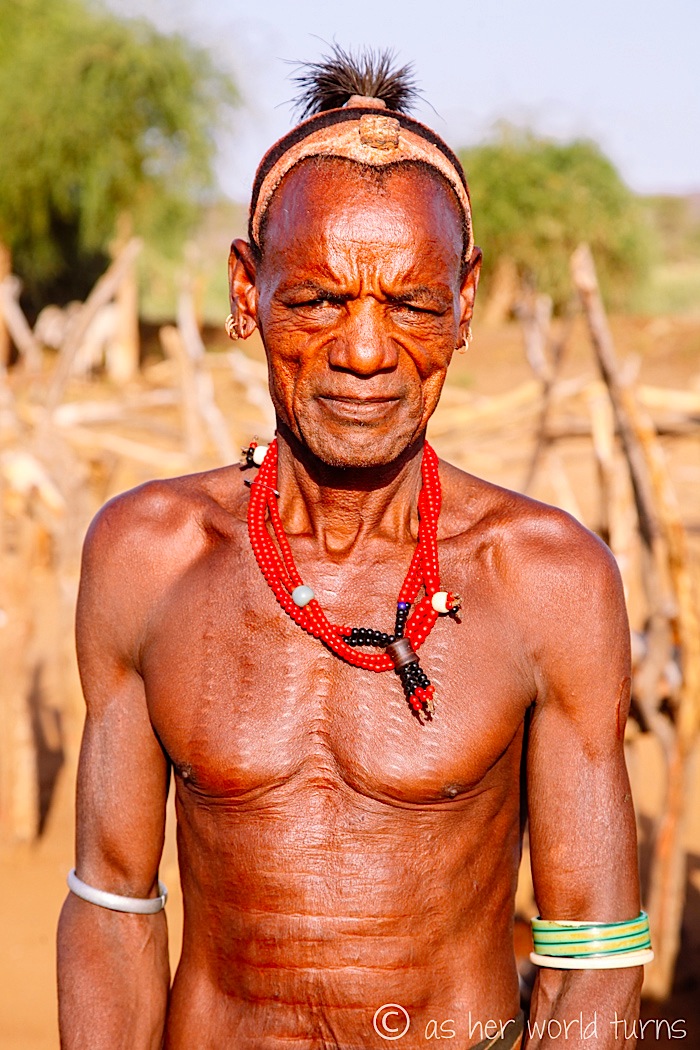
The girl on the left clearly enjoys posing. The others less so.

This is my first time being around openly nude tribespeople. They seem to have zero concept of shyness about their bodies and I marvel at how liberating that must feel to simply walk around and strut your stuff with no shame. On this first tribal visit my internal monologue is like, “WHOA, boobs… penis… bum…” as I can’t help being aware of the nakedness. But then, like flipping a switch, it ceases to catch my attention after this visit. I stop noticing nakedness with the rest of the tribes we visit in Ethiopia.
A closer look at the beadwork and shells woven into their garments:
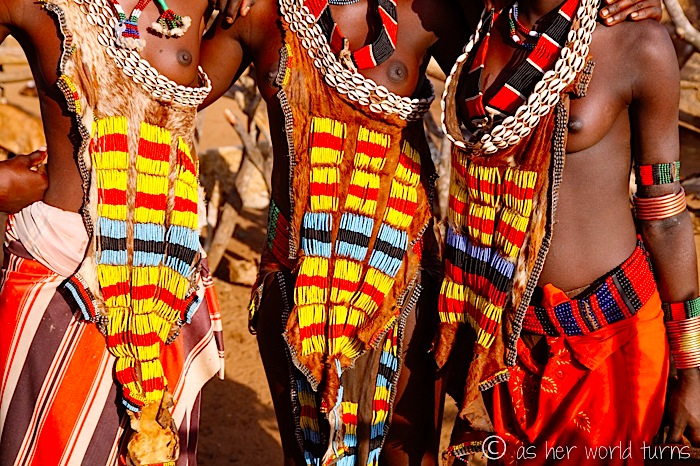

The daughters show off this little wooden stool that everyone carries. We saw them yesterday — some people hang them from their waist — and I had no idea what it was. Turns out they keep it handy so that it’s easy to pull up a seat anywhere.
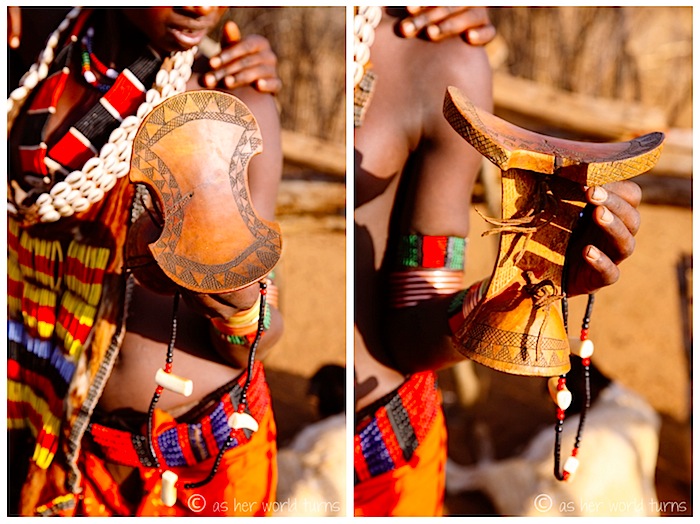
Young cattle and sheep and goats hang around their homes. The tribes in Omo Valley create fences out of tree branches as depicted below:
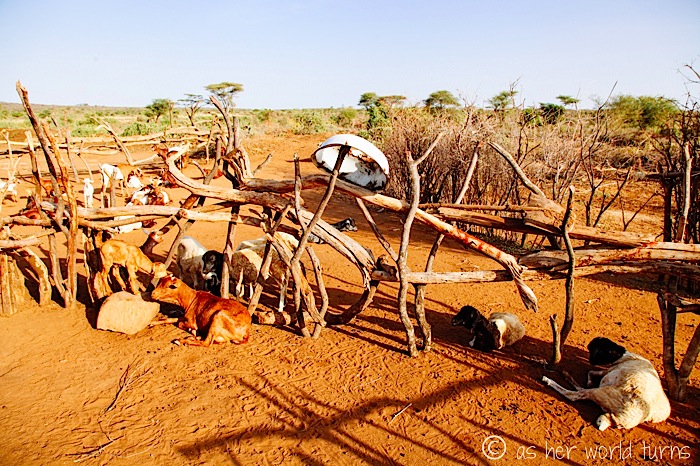
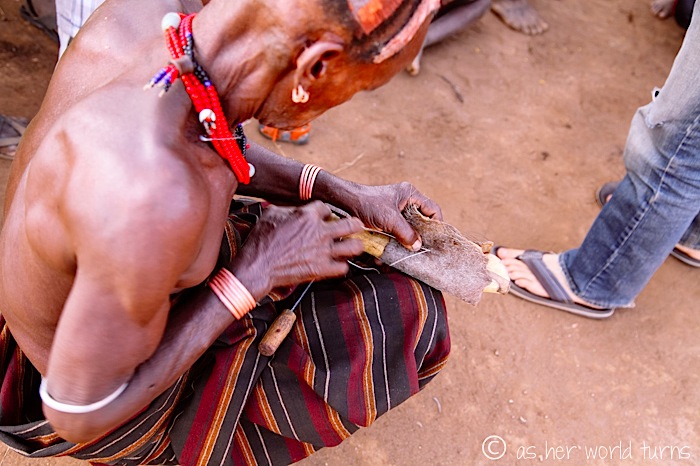
The patriarch works on sewing hide around this wooden handle — I think he tells us it will be a hammer or weapon of some sort when it’s completed.
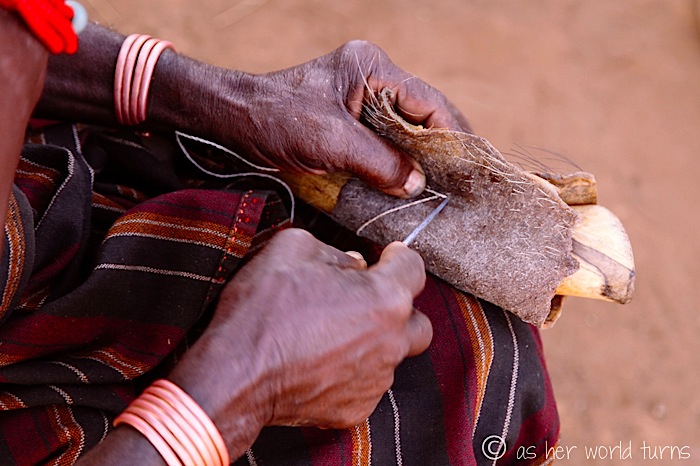
He poses with this young boy. I don’t know if it’s his son or grandson, and that’s not a question you ask in any culture. They are very sweet with each other.
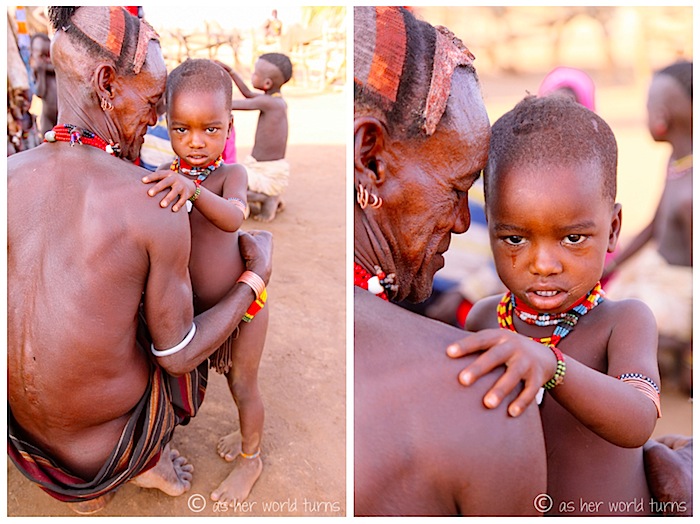
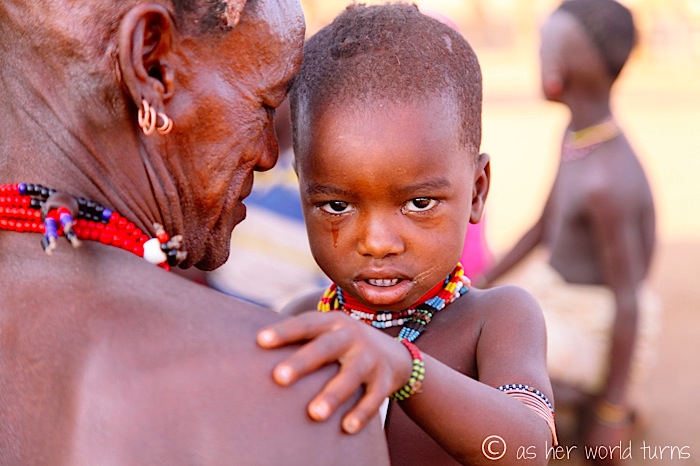
Our local guide asks if I want my photo taken with them. Sure!
One of these is not like the other:
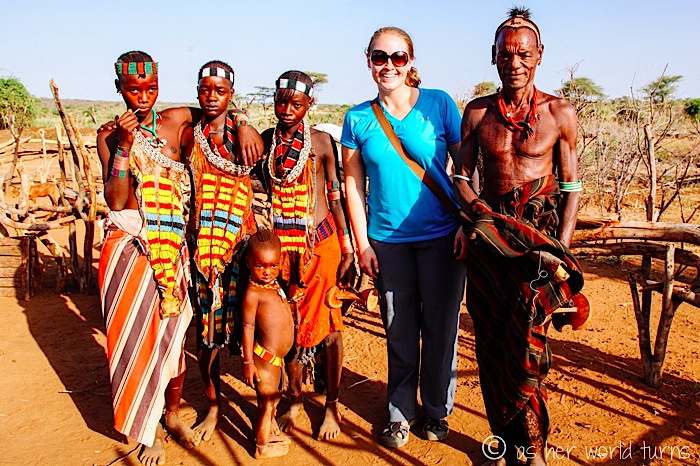
On our way back to the vehicle, an older woman carrying a young baby insists that I take her photo (for tip money). I oblige.

This is the inside of our vehicle. Tezera is our driver and the local guide for this tribe sits up front.

Mike and I are in the back. Tezera asks if we’d mind transporting one of the tribe members to our next stop, which is fine with us. He hangs out in the back and kindly poses for this photo:

More tribal shots from another area of Omo Valley coming tomorrow!

